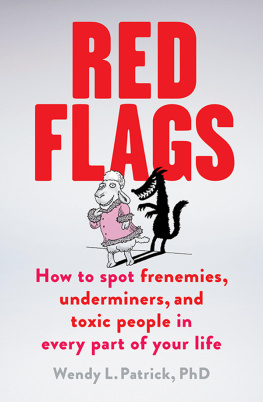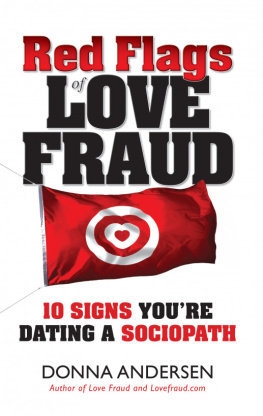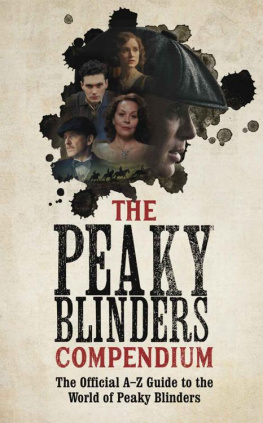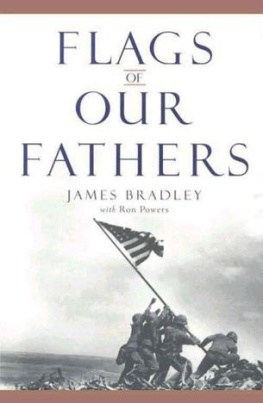Acknowledgments
I would like to thank a small, special group of people for their selfless contributions to this work. These people include fellow prosecutors Summer Stephan, Gary Schons, Kate Flaherty, and Bryn Kirvin, dear friends Don Cole and Craig and Linda Barkacs, and in particular, my sister, Jennifer Patrick and my mother, Elizabeth Patrickfrom whom the best ideas come.
ALSO BY WENDY L. PATRICK
Reading People: How to Understand People and Predict
Their BehaviorAnytime, Anyplace (revised and updated)
Using the Psychology of Attraction in Christian Outreach:
Lessons from the Dark Side
Bibliography
Adler, Ronald B., Lawrence B. Rosenfeld, and Russell F. Proctor II. Interplay: The Process of Interpersonal Communication. Oxford: Oxford University Press, 2010.
Albada, Kelly Fudge, Mark L. Knapp, and Katheryn E. Theune. Interaction Appearance Theory: Changing Perceptions of Physical Attractiveness Through Social Interaction. Communication Theory 12, No. 1 (2002) 840.
Ali, Farah, Ines Sousa Amorim, and Tomas Chamorro-Premuzic. Empathy Deficits and Trait Emotional Intelligence in Psychopathy and Machiavellianism. Personality and Individual Differences 47 (2009): 75862, doi: 10.1016/j.paid.2009.06.016.
Allan, Graham. Being Unfaithful: His and Her Affairs. In The State of Affairs: Explorations in Infidelity and Commitment, edited by Jean Duncombe, Kaeren Harrison, Graham Allan, and Dennis Marsden, 12140. Mahwah: Lawrence Erlbaum Associates, 2004.
Allen, Bud, and Diana Bosta. Games Criminals Play: How You Can Profit by Knowing Them. Sacramento: Ray John Publishers, 1981.
Andersen, Peter A. Influential Actions. In Perspectives on Persuasion, Social Influence, and Compliance Gaining, edited by John S. Seiter and Robert H. Gass, 16580. Boston: Pearson Education Inc., 2004.
Andersen, Peter A., and Laura K. Guerrero. The Bright Side of Relational Communication: Interpersonal Warmth as a Social Emotion. In Handbook of Communication and Emotion: Research, Theory, Applications, and Contexts, edited by Peter A. Andersen and Laura K. Guerrero, 30329. San Diego: Academic Press, 1998.
Anderson, Pamela M., Karin K. Coyle, Anisha Johnson, and Jill Denner. An Exploratory Study of Adolescent Pimping Relationships. Journal of Primary Prevention 35 (2014): 11317, doi: 10.1007/s10935-014-0338-3.
Apter, Michael J. Danger: Our Quest for Excitement. Oxford: Oneworld Publications, 2007.
Aron, Raphael. Cults, Terror, and Mind Control. Point Richmond: Bay Tree Publishing, LLC, 2009.
Aronson, Elliot. The Power of Self-Persuasion. American Psychologist. November: 87584, 1999.
Aronson, Elliot, Timothy D. Wilson, and Robin M. Akert. Social Psychology. 6th ed. Upper Saddle River: Pearson Prentice Hall, 2007.
Austin, Elizabeth J., Daniel Farrelly, Carolyn Black, and Helen Moore. Emotional Intelligence, Machiavellianism and Emotional Manipulation: Does EI Have a Dark Side? Personality and Individual Differences 43 (2007): 17989, doi: 10.1016/j.paid.2006.11.019.
Babiak, Paul, From Darkness into the Light: Psychopathy in Industrial and Organizational Psychology. In The Psychopath: Theory, Research, and Practice, edited by Hugues Herve and John C. Yuille, 41128. Mahway: Lawrence Erlbaum Associates: 2007.
Babiak, Paul, and Robert Hare. Snakes in Suits: When Psychopaths Go to Work. New York: Regan Books, 2006.
Babiak, Paul, Craig S. Neumann, and Robert D. Hare. Corporate Psychopathy: Talking the Walk. Behavioral Sciences and the Law 28 (2010): 17493, doi: 10.1002/bsl.925.
Back, Mitja D., Albrecht C. P. Kufner, Tanja M. Gerlach, Michael Dufner, John F. Rauthmann, and Jaap J. A. Denissen. Narcissistic Admiration and Rivalry: Disentangling the Bright and Dark Sides of Narcissism. Journal of Personality and Social Psychology 105, No. 6 (2013): 101337, doi: 10.1037/a0034431.
Back, Mitja D., Stefan C. Schmukle, and Boris Egloff. Why are Narcissists so Charming at First Sight? Decoding the Narcissism-Popularity Link at Zero Acquaintance. Journal of Personality and Social Psychology 98, No. 1 (2010): 13245.
Bacon, Terry R. The Elements of Power: Lessons on Leadership and Influence. New York: AMACOM, 2011.
Barrick, Murray R., Jonathan A. Shaffer, and Sandra W. DeGrassi. What You See May Not Be What You Get: Relationships Among Self-Presentation Tactics and Ratings of Interview and Job Performance. Journal of Applied Psychology 94, No. 6 (2009): 13941411, doi: 10.1037/a0016532.
Bauer, Jack J., and Dan P. McAdams. Growth Goals, Maturity, and Well-Being. Developmental Psychology 40, No. 1 (2004): 11427, doi: 10.1037/0012-1649.40.1.114.
Beauregard, Eric, Jean Proulx, Kim Rossmo, Benoit Leclerc, and Jean-Francois Allaire. Script Analysis of the Hunting Process of Serial Sex Offenders, Criminal Justice and Behavior 34, No. 8 (August, 2007): 106984.
Bereczkei, Tamas, Bela Birkas, and Zsuzsanna Kerekes. The Presence of Others, Prosocial Traits, Machiavellianism: A Personality x Situation Approach. Social Psychology 41, No. 4 (2010): 23845, doi: 10.1027/1864-9335/a000032.
Bereczkei, Tamas, Bela Birkas, and Zsuzsanna Kerekes. Public Charity Offer as a Proximate Factor of Evolved Reputation-Building Strategy: An Experimental Analysis of a Real-Life Situation. Evolution and Human Behavior 28, No. 4 (2007): 27784.
Bijvank, Marije Nije, Elly A. Konijn, Brad J. Bushman, and Peter H. M. P. Roelofsma. Age and Violent-Content Labels Make Video Games Forbidden Fruits for Youth. Pediatrics (2008): 870876, doi: 10.1542/peds.2008-0601.
Black, Pamela J., Michael Woodworth, and Stephen Porter. The Big Bad Wolf? The Relation Between the Dark Triad and the Interpersonal Assessment of Vulnerability. Personality and Individual Differences (in press) (2013): 15, http://dx.doi.org/10.1016/j.paid.2013.10.026.
Blau, Peter M. Exchange and Power in Social Life. Oxford: Transaction Books, 1986.
Bleidorn, Wiebke, Christian Kandler, Ute R. Hulsheger, Rainer Riemann, Alois Angleitner, and Frank M. Spinath. Nature and Nurture of the Interplay Between Personality Traits and Major Life Goals. Journal of Personality and Social Psychology 99, No. 2 (2010): 36679, doi: 10.1037/a0019982.
Boddy, Clive R. Corporate Psychopaths, Bullying and Unfair Supervision in the Workplace. Journal of Business Ethics 100 (2011): 36779, doi: 10.1007/s10551-010-0689-5.
Boddy, Clive R. Corporate Psychopaths: Organizational Destroyers. New York: Palgrave Macmillan, 2011.
Booth-Butterfield, Melanie, and Michael R. Trotta. Attributional Patterns for Expressions of Love. Communication Reports 7, No. 2 (Summer 1994): 11929.
Brand, Rebecca J., Abigail Bonatsos, Rebecca DOrazio, and Hilary DeShong. What is Beautiful is Good, Even Online: Correlations Between Photo Attractiveness and Text Attractiveness in Mens Online Dating Profiles. Computers in Human Behavior 28 (2012): 16670.
Brauer, Markus, and Richard Y. Bourhis. Social Power. European Journal of Social Psychology 36 (2006): 601616.
Bredow, Carrie A., Rodney M. Cate, and Ted L. Huston. Have We Met Before? A Conceptual Model of First Romantic Encounters. In Handbook of Relationship Initiation, edited by Susan Sprecher, Amy Wenzel, and John Harvey, 328. New York: Psychology Press, 2008.
Briggs, Peter, Walter T. Simon, and Stacy Simonsen. An Exploratory Study of Internet-Initiated Sexual Offenses and the Chat Room Offender: Has the Internet Enabled a New Typology of Sex Offender?
Next page











